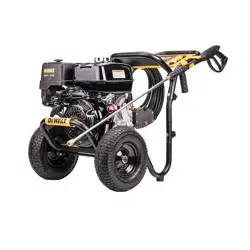Loading ...
Loading ...
Loading ...

ENGLISH
10
• Breathing exhaust fumes will cause serious
injury or death! Engine exhaust contains carbon
monoxide, an odorless and deadlygas.
• Operate pressure washer in a well-ventilated
area. Avoid enclosed areas such as garages,
basements,etc.
• Never operate unit in or near a location occupied
by humans oranimals.
WARNING: Risk of fire, asphyxiation and burning.
Never fill fuel tank when engine is running or hot. Do
not smoke when filling fueltank.
• Never fill fuel tank completely. Fill tank to
1/2" (12.7 mm) below bottom of filler neck to
provide space for fuel expansion. Wipe any fuel
spillage from engine and equipment before
startingengine.
• DO NOT let hoses come in contact with very hot
engine muffler during or immediately after use
of your pressure washer. Damage to hoses from
contact with hot engine surfaces will NOT be
covered bywarranty.
NOTICE: NEVER pull water supply hose to move
pressure washer. This could damage hose and/or
pumpinlet.
• DO NOT use hot water, use cold wateronly.
• Never turn water supply off while pressure washer
engine is running or damage to pump willresult.
• DO NOT stop spraying water for more than two
minutes at a time. Pump operates in bypass mode
when spray gun trigger is not pressed. When the
temperature inside the pump rises too high the
thermal relief valve (
20
, Fig.J) will open and
release a gush of water in an effort to lower the
temperature inside the pump. The thermal relief
valve will then close. If pump is left in bypass mode
for more than two minutes internal components
of the pump can bedamaged.
Fig. J
20
Start-up Procedure (Fig. A, K–Q)
1. In a well-ventilated outdoor area, add fresh, high-
quality, unleaded gasoline with a pump octane rating of
86 or higher. Do not overfill. Wipe up spilled fuel before
starting the engine. Refer to engine instruction manual
for correctprocedure.
IMPORTANT: Ethanol Shield™ (sold separately) is a fuel
stabilizer that helps eliminate and prevent ethanol
related problems in power equipment. Follow the
instructions on the container and add to thegasoline.
NOTICE: Use of fuels with greater than 10% ethanol
are not approved for use in this product per EPA
regulations and will damage the unit and void
thewarranty.
2. Check engine oil level. Refer to the engine instruction
manual for correctprocedure.
3. Check pump oil level. The oil level should come to the
dot in the middle of the sight glass. Refer to the Pump
paragraph underMaintenance.
4. Connect the water hose to the water source. Turn the
water source on to remove all air from the hose. When
a steady stream of water is present, turn the water
sourceoff.
5. Verify the filter screen
21
is in water inlet of pump. The
convex side facesout.
NOTICE: Failure to use an inlet screen filter may cause
damage to pump components and voidwarranty.
Fig. K
21
6. Connect the cold water source
22
to pump inlet.
NOTE: Water source must provide a minimum of 5
gallons per minute at 20 psi (138 kPa).
WARNING: To reduce the possibility of contamination
always protect against backflow when connected to a
potable watersystem.
7. Connect high pressure hose
16
to pumpoutlet.
Fig. L
22
16
8. If applying a chemical or cleaning solution, refer to
Chemicals and CleaningSolvents.
9. Turn the water sourceon.
NOTICE: Risk of property damage. Failure to do so
could cause damage to thepump.
10. Remove all air from the pump and high pressure hose
by depressing trigger until a steady stream of water
ispresent.
11. Turn the engine ON/OFF switch
8
to the ONposition.
Loading ...
Loading ...
Loading ...
